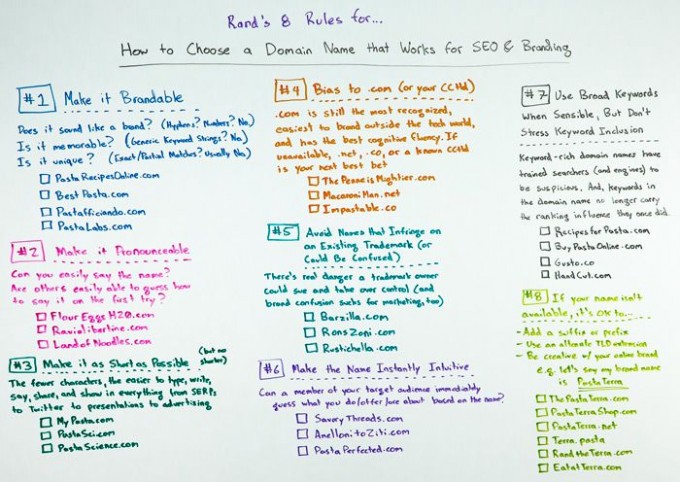
As a marketing strategist, you have charts and graphs and spreadsheets galore. The aim of that information overload is to guide you in a chess-like game: which move should you make next, and how will it affect your future strategy?
I’d be willing to bet that among all of the data you analyze, you haven’t given much thought to your domain name and how it fits into your overall marketing strategy.
That’s a bad move. Here’s why:
You need to build your domain name as a brand.

8 Rules for How to Choose a Domain Name
It needs to be quick and snappy. You want to be able to plaster it on all the graphics you produce for social media marketing. It should be easy to spell and even easier to say.
If your domain name is long and arduous, your online marketing efforts are going to be a drag. Don’t say I didn’t warn you!
But I already bought a domain name!

5 Popular WebSites To Buy Cheap Domain Names
If you already bought a domain name, all is not lost. Evaluate it with your team and find out what makes it only so-so (or downright awful) as a brand. New domain names typically only cost around $25, so you shouldn’t be in the red if you decide to buy a new one. Replacing the domain name on any existing images or graphics … that’s going to be a little more time consuming. Act now!
Now, I know what you’re thinking:
Is a keyword-rich domain name the smartest SEO strategy ever?

How to Choose a Domain Name for Maximum SEO
Good question! If your business sells custom waffle makers, why not go for customwafflemaker.com? Because Google is on to you, that’s why.
Keyword-rich domain names (or should I say exact-match domains, EMD for short) used to be super popular because they did, in fact, boost search engine rankings. Then Google rained on that parade in a big, big way, lowering the influence of domain keywords in search engine rankings to meaningless levels.
There are companies that still sell EMDs to innocent, unsuspecting web marketers for a pretty penny. Save your cash and don’t fall for this trick. Keep your domain name brand-able and you should do fine.
Let’s run through the characteristics of an effective, easy-to-brand domain name one more time:
- Easy to spell
- Easy to remember
- Easy to say
- Quickly suggests your company’s purpose
Notice what’s not on the list: “includes your coveted number-one keyword.” Don’t do it. However, that doesn’t mean you can’t include any keywords at all, ever. If you failed to include a single keyword, your domain name wouldn’t be able to accomplish point number 4: quickly suggests your company’s purpose.
In fact, if you need a little help with brainstorming a domain name, you can use a free tool like Nominus to help you out. There are many domain tools which will kick back all kinds of combinations if you enter a keyword or two. Some might be instant winners, and others might deserve to go straight to the trash bin. It’s up to you to sort it out.
So yes, do include some general keywords when it makes sense to do so. Forget about SEO for a second and you should be in the clear.
Meet your new friends, the gTLDs

An SEO’s Guide to Acquiring New gTLDs
This acronym might look like an unsavory disease or some compound you once had to memorize for a chemistry test, but in fact it stands for “generic top level domain.”
… Still lost? A gTLD is a domain extension. The most common one is, of course, .com.
Then there are .com’s cousins, .net, .gov, .org and .edu.
And if you step foot outside the US bubble every now and then, you are undoubtedly familiar with numerous country codes, like .ca for Canada or .au for our Aussie friends.
But there are new gTLDs for you to consider … over 600 of them, in fact. The Internet Corporation for Assigned Names and Numbers (ICANN for short) is in charge of approving applications for new gTLDs, but once one has been approved, anyone can buy it through a registrar.
Now instead of using the age-old .com extension, you can use one like .play or .books.
Remember how I said your domain name should be memorable and easy to spell? Most people will assume your website has a .com extension. So if you opt for a new gTLD (which can help with branding since it is something novel), make sure it fits with the rest of your domain name. There’s nothing more confusing than a site named imalawyer.music, for example. It’s also a good idea to buy the .com version of your domain name and redirect it to your main site just in case anyone gets a little confused about all this new gTLD business.
And there you have it: the essential considerations for choosing a domain name that will be a help—not a hindrance—during your future marketing efforts. You should be able to cross that off your to-do list in no time!




